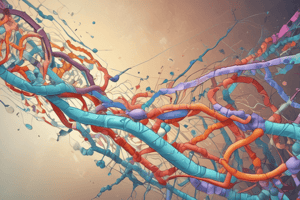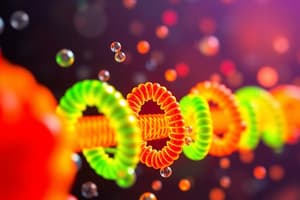Podcast
Questions and Answers
What is the purpose of using 1-fluoro-2-4-dinitrobenzene (DNB) or Sanger Reagent?
What is the purpose of using 1-fluoro-2-4-dinitrobenzene (DNB) or Sanger Reagent?
- To break the bonds in a polypeptide chain
- To synthesize a polypeptide chain
- To determine the entire sequence of a polypeptide
- To identify the first amino acid in a polypeptide chain (correct)
What is the outcome of using Sanger Reagent under acid conditions?
What is the outcome of using Sanger Reagent under acid conditions?
- The formation of a complex with the first amino acid
- The extraction of the derivative of the first amino acid
- The breaking of bonds in the polypeptide chain (correct)
- The synthesis of a new polypeptide chain
What is the advantage of using Edman Degradation over Sanger Reagent?
What is the advantage of using Edman Degradation over Sanger Reagent?
- It does not break the bonds in the polypeptide chain (correct)
- It is only used for synthesizing polypeptide chains
- It is faster and more efficient
- It is more expensive and time-consuming
What is the result of using Sanger Reagent repeatedly?
What is the result of using Sanger Reagent repeatedly?
What is the reagent used in Edman Degradation?
What is the reagent used in Edman Degradation?
What is the purpose of using Thin Layer Chromatography (TLC) in protein sequencing?
What is the purpose of using Thin Layer Chromatography (TLC) in protein sequencing?
What is the role of zinc ion in thermolysin?
What is the role of zinc ion in thermolysin?
What is a characteristic of the Lock-and-Key Model of enzyme action?
What is a characteristic of the Lock-and-Key Model of enzyme action?
Which amino acids are resistant to heat?
Which amino acids are resistant to heat?
What type of bonds are cleaved by thermolysin?
What type of bonds are cleaved by thermolysin?
What is the purpose of the Enzyme-Substrate complex?
What is the purpose of the Enzyme-Substrate complex?
What is the function of proteins in the body?
What is the function of proteins in the body?
Which model of enzyme action is more consistent with a wider range of enzymes?
Which model of enzyme action is more consistent with a wider range of enzymes?
What is the result of the reaction within the active site of the Enzyme-Substrate complex?
What is the result of the reaction within the active site of the Enzyme-Substrate complex?
What is the primary structural component of all tissues in humans and animals?
What is the primary structural component of all tissues in humans and animals?
What is the function of an enzyme in a reaction?
What is the function of an enzyme in a reaction?
How are proteins composed?
How are proteins composed?
What is the overall reaction for the conversion of substrate to product?
What is the overall reaction for the conversion of substrate to product?
What happens to an enzyme at extreme temperatures?
What happens to an enzyme at extreme temperatures?
What is the optimal pH range for most enzymes?
What is the optimal pH range for most enzymes?
What is the effect of increasing substrate concentration on the reaction rate?
What is the effect of increasing substrate concentration on the reaction rate?
What is the role of cofactors and coenzymes in enzymatic activity?
What is the role of cofactors and coenzymes in enzymatic activity?
What is the effect of a competitive inhibitor on the reaction rate?
What is the effect of a competitive inhibitor on the reaction rate?
What is the term for the temperature at which an enzyme's reaction rate is highest?
What is the term for the temperature at which an enzyme's reaction rate is highest?
What is the mechanism of action of noncompetitive inhibitors?
What is the mechanism of action of noncompetitive inhibitors?
What is the naming convention for many enzymes?
What is the naming convention for many enzymes?
How are enzymes classified by the International Union of Biochemists?
How are enzymes classified by the International Union of Biochemists?
What is the biochemical activity of oxidoreductases?
What is the biochemical activity of oxidoreductases?
What is the effect of noncompetitive inhibitors on the enzyme reaction rate?
What is the effect of noncompetitive inhibitors on the enzyme reaction rate?
What is the function of sucrase?
What is the function of sucrase?
Flashcards are hidden until you start studying
Study Notes
Thermolysin and Proteins
- Thermolysin is a thermostable zinc endopeptidase that contains a zinc ion for catalysis and four calcium ions for thermal stability.
- It cleaves peptides at amino-linked bonds of aliphatic amino acids (e.g., Val, Ile, Leu) that resist heat.
- The proposed mechanism for thermolysin-catalyzed cleavage of peptides involves the cleavage of amino-linked bonds of aliphatic amino acids.
Enzyme Function and Specificity
- Enzymes are highly specialized and have specific purposes in the body.
- Enzymes are composed of amino acids linked together.
- Enzymes increase reaction rates by decreasing the activation energy.
- Enzymes have varying degrees of specificity for substrates, recognizing and catalyzing a single substrate, a group of similar substrates, or a particular type of bond.
Mechanism of Action of Enzymes
- Enzymes increase reaction rates by decreasing the activation energy.
- Enzyme-substrate interactions involve the formation of an enzyme-substrate complex through the lock-and-key model or the induced-fit model.
- The lock-and-key model describes the active site as having a rigid shape that only allows substrates with the matching shape to fit.
- The induced-fit model describes the active site as flexible, adjusting to maximize the fit with the substrate.
Factors Affecting Enzyme Activity
- Environmental conditions, such as temperature, pH, and substrate concentration, affect enzyme activity.
- Optimum temperature, pH, and substrate concentration vary for different enzymes.
- Cofactors and coenzymes, such as inorganic substances and vitamins, are sometimes necessary for proper enzymatic activity.
Enzyme Inhibitors
- Enzyme inhibitors slow down the reaction rate by binding to the active site, reducing the enzyme's activity.
- Competitive inhibitors resemble the substrate and bind to the active site, reducing the enzyme's activity.
- Non-competitive inhibitors bind to a different location on the enzyme, causing a conformational change that slows down the reaction rate.
Studying That Suits You
Use AI to generate personalized quizzes and flashcards to suit your learning preferences.




